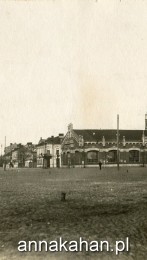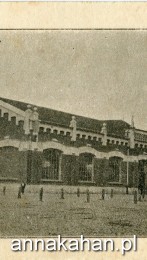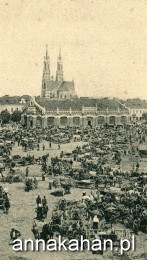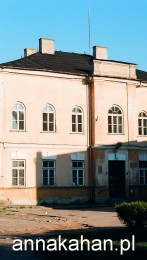[The Jewish Hospital]
The need to found a hospital, which would provide medical care for the Jewish people, was agreed at a meeting of a committee in 1869. Construction plans and cost estimates were presented to the Ministry of the Interior. After the corrections in the project were made and sufficient funds were raised, the construction received approval. The three-storey building was erected between 1890 and 1891. The construction was supervised by Josef Zając. Construction of the hospital was co-financed by the Tsarist authorities. The money came from penalties imposed on the Jews who did not conform to the European dress code.
The inscription “JEWREJSKAJA BOLNICA” and the date “1891” were placed on the façade of the building. On December 31, 1891, the hospital was opened. The hospital was located at the corner of Piękna Street (now Pułaski Street) and the Market Square, on the square that belonged to the Jewish community. The site was large enough to also accommodate a big orchard. The old Jewish cemetery, which was closed in 1825, belonged to the hospital building as well.
Medical care was provided mostly to poor people. In order to assure income and cover all the hospitals’ expenses, the Gubernatorial Government took advantage of the hospital being located by the market square and decided to build market stalls, which would be available for the public to rent. Part of the needed funds came from the Jewish Community Council.
The hospital had several wards: two general wards, two isolation wards (infectious disease wards), a labour and delivery ward, an operating room (established in 1905), an outpatients’ clinic, a reception, a kitchen, a laundry and other utility rooms. It employed a chief doctor (and a director), a clerk, a paramedic, a midwife, two nurses, a cook, a laundress, and two caretakers. In Anna Kahan’s time, the Jewish hospital provided health care for Russian soldiers taken prisoner by the Germans.
A journal entry from June 8th 1915 contains information about hospital conditions and Anna's description of her mother's boil removal procedure .
“But here we are. We go upstairs and are told to wait in the hall. No place to sit except for the stairs. We put Mameshe down, then I sit down and she rests her hand on my shoulder. How long will we wait? When we ask, they shout at us.
Finally, they take Mameshe into the operating room. Tateshe and I are left in the corridor.
We stand behind the door, listening. Time drags endlessly. Suddenly, a piercing cry! And another, and another!
It drives me mad. I don't even know I'm pacing the floor, praying: "Dear God, give her strength, send her a refue ('cure')," until my father stops me. "It''s over," he says. "Thank God, it's over."
They bring her out all flushed and doubled with pain. She is given Valerian drops as she is about to faint. The porter helps us put her into the coach and we drive off. “What a hospital,” she says, breathing heavily. “They operate with dull instruments. Rusty, too. In the middle of cutting, the doctor yelled, 'Why haven't they sharpened them?' “
Back home we put her to bed. She is very weak.After the war, the hospital building housed a dental outpatient clinic equipped with x-ray room. Following this, the building was demolished and apartment houses at 9 Armii Krajowej Street were built in its place. The adjacent Market Hall building was erected between 1908 and 1909 in order to regulate the food trade. After thorough renovation, the Market Hall reopened its doors at the end of 2013.





